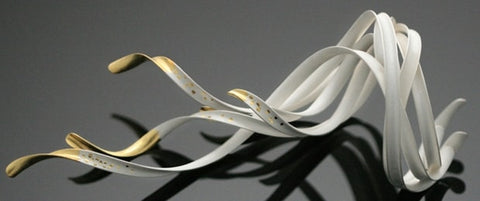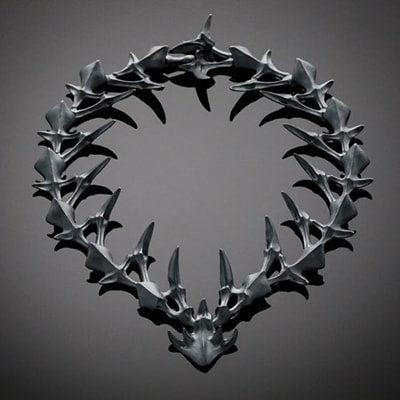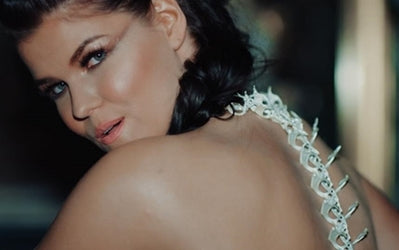Chao & Eero: Where Light and Darkness Intersect
Posted on November 01 2018

An Interview with Chao-Hsien Kuo and Eero Hintsanen
This story started out with a little evening humor, commenting on "The Ceremony," posted on Instagram. The provocative yet profound black and white picture of unclothed lady entering a lake, wearing a prominent and heavy silver necklace, in reverse, running down her back, was not something that you see every day. When the designer answered back with a humorous response, I had to find out who he was.
As it turned out, he and his wife, known as Chao & Eero, are both renowned jewelers in Finland, recognized at home and abroad. They work together on a jewelry line as well as separately, managing their own individual brands. The contrast in styles opposes each other. Yet the distance from the “center” is equal and the contrast symmetric, balancing each other out. Understanding them as individuals makes the dissonance understandable.

Chao the Light
Born in Southern Taiwan in 1973, her, journey into the jewelry world was not exactly linear. Although inclined towards handicrafts and knitting from an early age, she did not realize that she wanted to be a jewelry designer and goldsmith until later in life. Chao’s father, an engineer, operated a metals business. Typical of many Asian families, Chao's parents encouraged her to study and pursue a profession, offering good income and stability. Enrolled in the best girl's school in Southern Taiwan, she spent six years studying for the national university entrance exam.
Although passing the, she did not receive the high score, require to enroll in the National University. At that point, she was utterly exhausted and had no idea what she wanted to do. Most in this situation study for another year and retake the exams, hoping to improve their results. However, she went against the grain and decided to enroll in the Ming Chuan College for Commercial Design, a private college in Taipei (1991). The "failure" of attending a private college to study design was a turning point in her life. The school exposed her to another world, completely different than what she experienced before. Encouraging creative thinking, drawing, and working with her hands, she started to enjoy school and learn new things. During that year in Taipei, she attended many exhibitions, one of which was a gold jewelry exhibition, which planted a seed in her mind.
After a year, she went to Ontario, Canada ('92-93) to study English. Her father asked a friend over there to help Chao find a business school, which she could study and later return home, helping internationalize the family business. He directed her to the city library where she spent hours browsing college catalogs. However, instead of searching for business programs, she started looking into ones offering metal, jewelry, and art studies.
This time, her academic discipline, ingrained since childhood, paid off. Having excellent grades and a strong portfolio from Ming Chuan college, she applied to and received acceptance from several top American schools. Her father asked, “jewelry needs to be designed?” Nevertheless, he was supportive when they discovered that there was no jewelry school in Taiwan. Because her father had a friend in New Jersey, she chose to enroll at Hofstra University (1993), located in Long Island, New York, majoring in fine arts and sculpture.
One of her professors had unusual expertise with metals, opening up Chao’s interest in keum-boo and anticlastic techniques. Keum-boo is a laborious technique, dating back to ancient Korea. The artisan depletes the silver with several applications of acid, until the silver has a white finish, and then gilds it with 24-karat gold foil. Anticlastic is a technique to create 3D “saddle-shaped” designs, which oppose each other in a symmetrical manner. She analogized a Pringles potato chip as being anticlastic with its long edges opposing each other. Through the years, Chao developed her own anticlastic techniques and applied keum-boo to three-dimensional works that are very different from others, creating her own signature style.

The Nordic Wind Bracelet illustrates both anticlastic forming and keum-boo techniques.
Looking to build upon those skills, her professor encouraged her to look at the Lahti University of Applied Sciences – Institute of Design. The Goldsmith and jewelry design program, offered in English, was especially well-known for metal forming techniques: manipulating materials to make them look different and draw attention. There was an excellent facility with many teachers, considered masters in their profession. They offered courses in goldsmithing, stone setting, silversmithing, engraving, enameling, and gemology. After graduating from Hofstra University (1996) with High Honors in Fine Arts (Jewelry/Metal), she enrolled in the post-graduate Goldsmithing and Jewelry Design program (1997) at Lahti University. Shortly after arriving in Finland, she met Eero who shared the same passion for the metals and design, challenging yet embracing convention at the same time.
After graduation in 1999 and earning her Master Goldsmith Certification (Mestarinkirja), she returned to Taiwan, taking an apprenticeship at the Saga Co as a watch designer. There, she learned how to operate within the corporate environment, managing interdepartmental relations and finding the intersection between art and commerce.

The Sparkling Forest Earrings take inspiration from the fresh snow.
Returning to Finland in 2000, taking up a Master of Arts (MA) in Industrial Design at Aalto University. As an immigrant to Norway, I assumed that Finland must have been a shock for her. Typical of northern countries, the long dark winters, inclement weather, and the people's general silence makes adjustment difficult. However, for Chao, Finland offered new stimuli and matched her generally introverted persona, characteristic of artists and designers focused on their work. Over the course of her studies and career, she defined her style, taking inspiration from nature. Plant life and sometimes the snow, which was new for her, offered not only inspiration but something to study. Taking a close look, she captures how the intricate structures and assemblies aid movements that we take for granted.
On Valentine's day 2005, she and her husband started Chao & Eero. Shortly thereafter (2006), Lapponia discovered her work and offered her a freelance designer position. Renowned as Finland's most well-known jewelry brand, Lapponia supplied Princess Leia's (Carrie Fisher) necklace in the first Star Wars movie (1977). They wished to lighten the heavy and sculpture-like forms, characteristic of their designs. Selecting Chao, the first woman, they sought originality that still embraced the brand, especially with regards to the sculptural qualities.
Based on disciplined creativity and a desire to learn, Chao makes a statement. However, it is in a calm and soothing manner, blending in with the person wearing her pieces. Conforming and grounded, she expresses something unique, absorbed from not only her current surroundings but also the journey across three continents. During her career, she has received numerous awards and grants as well as international recognition. Even the New York Times covered her work with Lapponia. You can learn more about her and her creations on her website.
Eero the Darkness
Born in Eastern Finland (1972), Eero grew up on a farm, surrounded by a vast and dark forest. During the pre-digital age, he escaped into other worlds through comics and novels like John Carter and the Lord of the Rings. Like many children during that time, playing in the countryside without parental supervision, he used his imagination to visualize those stories and whatever else he could conjure up. They fashioned branches and sticks into swords and other weapons, taking on invisible forms in the darkness. From those early years, he also enjoyed drawing with pen and pencil, conveying these images to others.
His parents were supportive and free, suggesting that he look beyond farming. Finland's entry into the EU (1990's) meant inevitable changes to the agricultural sector. After doing his mandatory army service, he applied to the Lahti University of Applied Sciences – Institute of Design. Passing the demanding four-day entrance exam, he entered a school in flux (1993). The university wanted to break from traditional teaching methods and curriculums, coming up with a completely different approach while upholding high standards. Experimenting with the curriculum and admissions, they sought a diverse class that would not only compliment each other but also clash as well, engaging in healthy conflict.

The Tri Necklace | Eero Hintsanen
During his Goldsmith studies in Lahti, Eero spent a year in Germany (1995-1996). He worked at a Munich jewelry store and studied at the Staatliche Zeichenakademie in Hanau, Germany. Founded in 1772, the State Drawing Academy is one of Germany's oldest schools for creative crafts and recognized internationally. Returning to Finland, he completed his Bachelors of Arts in Goldsmithing in 1998.
After graduation, he co-founded Group X8 with several others, participated in international jewelry shows, taught part-time at several different institutions, and cofounded Chao & Eero in 2005. He also continued his studies: taking a post-graduate degree in entrepreneurship (2002-2004) and specializing in Jewelry Art in Lahti (2004). In 2010, Eero earned his Master Goldsmith certificate (Mestarinkirja). After certification, he taught at the Aalto University, School of Arts, Design and Architecture in Finland (2010-2011). In 2015, Eero earned his Master in Arts (MA) in International Design Business Management (IDBM), which broadened his knowledge and further qualified him to teach at the university level.
Eero built a reputation as an exceptional jeweler and craftsman, specializing in statement jewelry. Known as restless and unbound, he is amicable and pragmatic, taking time to understand the customer and visualize their ideas. In addition to folklore and mythology, Eero draws inspiration from Finland's "Dark Aesthetics," influenced by the long and dark winters. The culture draws strength from the darkness. It is quite prevalent in the Nordic countries and part of people's lives. It is most visible in the black metal music scene and the tattoo art that goes along with it.
The Spine Necklace, featured in the 2018 Eurovision song contest brought him front and center. In 2017, through a common acquaintance, in the fashion industry, he met Saara Aalto – the Finnish Eurovision contestant for 2018. He was given a budget, complete trust, and creative freedom to make something never seen before.

Saara Aalto in Eurovision 2018 (video) - wearing the Spine Necklace for "Monsters."
The necklace, as Eero sees it, is "a skeleton removed from a skeleton" but with more prominent roots. There was no single thought, idea or point of inspiration that led to the design concept. Rather, it was a culmination of inputs over the years, going back to his childhood years; moving through the forest at night, where he deliberately sought "long and snappy" shapes. Once he had a picture in his mind, he fashioned something that resembled a combination of bones and thickets while considering Saara's unique situation: on stage in front of almost a 200 million people, seen from all angles, using microphones, and performing energetic movements. The piece had to be prominent but not take attention from the singer herself. It had to be a natural part of her outfit and onstage persona.
The necklace not only had to stand out but also fit perfectly and in a flexible manner. Eero visited the YLE (Finnish Broadcasting Company) studio around seven times to make adjustments as part of a team, which made this big and complex project happen. Saara and Eero, both down to earth, worked well together, pulling it off over a three week period.
Chao & Eero
In their studio, they do their own casting and limit the use of 3D printing, keeping production limited. Linking the design process to the design itself, they can spontaneously alter pieces during the making process instead of waiting for vendors and dealing with the associated formality and potential delays. Casting in-house also allows them to test small pieces, scaling them up into magnificent ones in short order. They often refer to each other to get outside and professional perspective if they get "tunnel vision" from working on the same thing for too long.
At the end of the interview, they both emphasized that school was the defining factor in their professions. The expert mentorship and high standards, which demanded attention to detail while challenging their creativity, laid the foundation for an illustrious career. The students at School of Goldsmithing – Institute of Design in Lahti Finland spent well over 80 hours per week in and out of the classroom. Night or day, there was a teacher present who wanted them to learn and succeed. They told me that the student to teacher ratio was around 10:1 - something almost unheard of today. The heated discussions among peers got them to think differently, emphasizing not to get stuck: instead, reinvent and reinterpret. Hence, the school gave the students both reasoning and context, helping each of them find their own direction.
Their collective and individual designs are for those searching for something different in a world of mass production and general uniformity. You can find them online and on social media.
https://www.chao-hsienkuo.com/
https://www.eerohintsanen.com/

